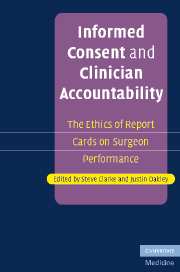Book contents
- Frontmatter
- Contents
- List of contributors
- Acknowledgements
- Introduction: Accountability, informed consent and clinician performance information
- Part I Accountability
- Part II Informed consent
- Part introduction
- 7 Informed consent and surgeons' performance
- 8 The value and practical limits of informed consent
- 9 Against the informed consent argument for surgeon report cards
- 10 Trust and the limits of knowledge
- 11 Surgeons' report cards, heuristics, biases and informed consent
- 12 Report cards, informed consent and market forces
- Part III Reporting performance information
- Index
- References
11 - Surgeons' report cards, heuristics, biases and informed consent
Published online by Cambridge University Press: 08 August 2009
- Frontmatter
- Contents
- List of contributors
- Acknowledgements
- Introduction: Accountability, informed consent and clinician performance information
- Part I Accountability
- Part II Informed consent
- Part introduction
- 7 Informed consent and surgeons' performance
- 8 The value and practical limits of informed consent
- 9 Against the informed consent argument for surgeon report cards
- 10 Trust and the limits of knowledge
- 11 Surgeons' report cards, heuristics, biases and informed consent
- 12 Report cards, informed consent and market forces
- Part III Reporting performance information
- Index
- References
Summary
Informed consent and surgeons' performance information
An important reason for providing patients with performance data on individual surgeons is to enable patients to make better decisions about surgery, as a part of the informed consent process. Surgeons' performance data can be utilized to enable a variety of types of decision that a patient may face. A patient can utilize performance data on individual surgeons to enable a choice between available surgeons. A patient can utilize surgeons' performance data when deciding between surgery involving an available surgeon and a non-surgical alternative form of treatment. Also, a patient can utilize surgeons' performance data to help decide whether or not to wait for a high-performing surgeon, who is not currently available, to become available.
Traditionally, performance data on individual surgeons have not been disclosed to patients, and such data have not usually been thought necessary to disclose for the purposes of providing effective informed consent. Canonical treatments of the doctrine of informed consent, such as Faden and Beauchamp (1986), do not consider the possibility of making such information available to patients. However, it has recently been argued that the doctrine of informed consent implicitly requires that surgeons' performance data be made available to patients (Clarke and Oakley, 2004). The gist of this argument is easy enough to grasp: it is uncontroversial that the significant and material risks associated with an operation should be disclosed to a patient who is contemplating that operation.
- Type
- Chapter
- Information
- Informed Consent and Clinician AccountabilityThe Ethics of Report Cards on Surgeon Performance, pp. 167 - 179Publisher: Cambridge University PressPrint publication year: 2007
References
- 3
- Cited by



